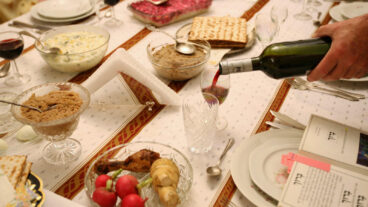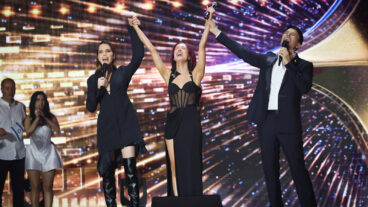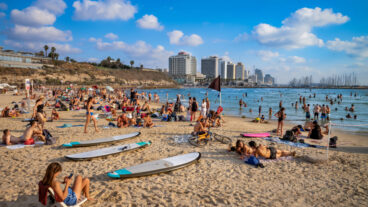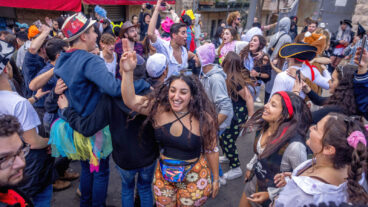Some 30,000 painstakingly modeled and painted human figurines dot Mini Israel, including 4,500 military and sports figurines that actually walk, wave their arms and kick around soccer balls.Yoni Shapira is a big guy who likes little things; 1:25 scale little things, to be exact. The 50-year-old native Israeli is the creative visionary behind Israel’s newest and most popular tourist attraction – Mini Israel – a 15-acre theme park boasting eight acres of exact miniature replicas of over 300 of the country’s most famous sites and cities.
According to the amiable Shapira, the displays at Mini Israel join 47 similar miniature theme parks in over 25 countries worldwide, with Holland’s acclaimed Madurodam and Italy’s Italia in Minatura in Rimini offering initial examples for the park. A ‘soft launch’ was held on Nov 15, 2002, and President Moshe Katzav officially inaugurated the park on April 15 standing before a scale-model replica of his home -the Presidential Residence in Jerusalem. Since then, crowds of Israelis as well as a steady trickling of tourists have been patronizing the park and have been dazzled by its offerings.
Mini Israel, located just off the main highway in the Latrun Valley about midway between Jerusalem and Tel Aviv, sits amid the agricultural fields of Kibbutz Nachshon in a developing tourism triad with two other notable sites: the nearby Israel Defense Forces Armored Corps tank museum, and the scenic Trappist Latrun Monastery. The park is laid out in the shape of a Star of David, dividing the country into separate geographic regions and thematic areas.
“The hardest part was what not to put in,” Shapira says about the locations featured at the park. And a quick glance will show you there’s something for everybody’s tastes.
Holy sites and structures revered by Jews, Muslims, Christians, Druze and Baha’i abut raucous modern-day soccer and basketball stadiums; ancient ruins sit back-to-back with busy cities; breathtaking green Galilee vistas overlook rugged desert landscapes and busy industrial areas and airports noisily park alongside pastoral kibbutz communities and sleepy Arab villages. The management’s policy was to choose locales that allow tourists to “identify with parts of Israel,” Shapira says.
Careful effort was put into representing the traditional garb of nearly all the religious factions among the Jews, Moslems and Christians shown at the park, Shapira wryly adds, something that will hopefully keeping Mini Israel from becoming another – albeit Lilliputian – flashpoint of Mideast controversy.
A marketing expert with more than 20-years experience in high-level tourism here, Shapira in the past guided local and international organizations and groups, VIPs, and educators. The idea for Mini Israel was sparked when Shapira – after a friend shared impressions of a visit to the Madurodam theme park at the beginning of the 90s – thought to himself: “Why not do this in Israel?”
His curiosity piqued, he returned to Israel from a stint as emissary in Australia for the United Jewish Appeal during the 1991 Gulf War.
The $20,000,000 project is backed by investors Granit Hacarmel, which owns Tambour paints, Sonol gas stations; the Borovitch Group, owners of Arkia Airlines; and Secum, which heads the Shikun Ovdim and Solel Boneh real estate development group. Sponsors of the project include major concerns like the Egged bus cooperative, which sports a projected model of an as-yet unbuilt bus museum, as well as busses running to-and-fro on roads stitched throughout the site; the Coca Cola bottling company, which is represented by their landmark B’nai Brak plant; and Tnuva dairies. The models of the Coca Cola and Tnuva dairy bottling plants are a wonder to behold; both a clanking whirr of whizzing bottling production lines, production-line workers, forklifts and waiting semi-trailer trucks.
Shapira says Mini Israel’s operators have already sold a model to Turkey, and that there are two tenders for similar parks in India.
All of the 17 current model makers are immigrants from the former Soviet Union, Shapira says proudly. Some 30,000 painstakingly modeled and painted human figurines dot the site, including 4,500 military and sports figurines that actually walk, wave their arms and kick around soccer balls.
An example of the intricate detail invested in the park can be seen in the exciting soccer game played at the pint-sized version of Jerusalem’s Teddy Stadium. The players run all over the field as they pass the ball from one to another; the colorful crowd, cheering in the bleachers, does the ‘wave’ as goalies block scoring kicks. All that’s lacking are the traffic jams outside of the arena on game nights. The hotly contested match, played between the capital’s hometown Betar team and rival Haifa’s Hapoel always winds-up a tie, thanks to computerized system controlling the player’s random maneuvers. If only fate and fans were as kind to Betar.
And when all those tiny people tire of the physical activity, they can hop in one of the 3,500 motorcycles, cars, vans, trucks, buses, and some 100 seafaring vessels and 20 airplanes and helicopters wending their way around and over the site.
One ten-year-old who spent the entire visit bouncing along the lanes from scene-to-scene like a human pinball, was ready to come back at a minute’s notice. “The park is really cool, and the technology is amazing – they had a great idea when they made Mini Israel,” he said.
Mini-Israel boasts some 30 miles of an Israeli-patented drip irrigation system that waters 50 diverse species of 20,000 miniature trees. 300 kilometers of electric cables and fiber optics run underground, powering dynamic items and lighting laced throughout the displays. The cabling all feeds into eight central control ‘pillars’ which in turn all run to main computer banks, Shapira explains.
Over 60,000 people visited Mini-Israel in July of 2003 alone, making it the most-visited tourism site nationwide. When the management opened the gates until 11 PM for late evening visits in the last week of July, Shapira says the attendance jumped to 4.300 daily, with another 3,000 plus evening sightseers beating the scorching midsummer heat.
Tourism to Israel continues to grow, according to Tourism Ministry Spokesperson Nitsan Ilan. She recently led a gaggle of reporters, who, with family and children in tow, were invited to see the flag-festooned theme park on a sunset tour. She said that despite concerns about regional strife, more and more groups were returning to Israel, slowly but surely reversing a three-year free fall in incoming tourism since the outbreak of the current conflict.
North American visitors make up about 25% of the total number of tourists to Israel, according to recent statistics, with some 100,000 visitors entering Israel in June 2003. Those figures are a 44% increase over last year, with Tourism Minister Benny Elon reportedly expecting 1.2 million visitors Israel in 2003.
One can readily see that Mini Israel is a developing work in progress. When asked, for example, why the park isn’t studded with shade-providing canopies, Shapira, a stickler for accuracy, says that that would break the authentic sightlines from locale to locale within the facility. The park’s administration, however, plans to provide more shaded seating areas, he adds.
Shapira, bringing his tour guide knowledge and marketing acumen to bear on choosing content and deciding which sites to feature, says, “You see yourself at the marketplace, the beach, the Wailing Wall, and at the churches.”
There is a ‘wish list’ for some 70 more models, Shapira says, but adds as an example of the models’ construction pace that two-years of painstaking research alone are going into the architectural details of model in Jerusalem’s Church of the Holy Sepulcher.
But amid all the inclusions, something obvious stood out by its very absence: any sign of Israeli or Palestinian national aspirations east of the rapidly expanding security fence – or wall, along the pre-1967 Green-Line. A French radio correspondent, though duly impressed with the burgeoning site, dryly noted the dearth of significant Palestinian locale – citing Ramallah as an example. Another wondered aloud why no Israeli settlements were included.
Deftly avoiding the political fray over why no hotly contested Jewish or Palestinian communities in the West Bank are included, Shapira points out the Jezreel Valley settlement of Nahalal, sited well within Israel proper. Set under glass, the venerable pie-shaped community is birthplace to Six-Day War hero Moshe Dayan, and the final resting place of Israeli astronaut Ilan Ramon. Shapira also mentions plans for a model of the 6th century Sussia archeological ruins, south of Hebron, but cites budgetary constraints and the need for prioritizing less controversial locations.
“We’re trying to show how Israelis can live and not how they die,” Shapira riposted one British interviewer, who asked why terror attack sites were not noted. “I want people to drop their guard. Israel is a place that’s worth a visit,” he says, hoping that those visitors will readily appreciate the embarrassment of riches of Israel’s diverse wealth of natural beauty and stunning man-made sites adorning the country. “We want them to visit with a smile, and appreciate that this is a unique place, and not only because of what dominates the news.”











